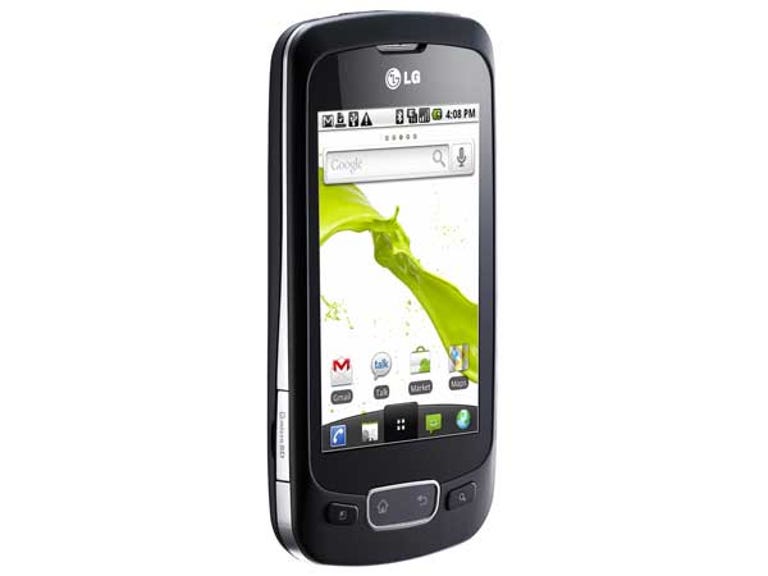 Why You Can Trust CNET
Why You Can Trust CNET LG Optimus One P500 review: LG Optimus One P500
The LG Optimus One is a sturdy budget Android handset that includes some useful features and provides a pleasant user experience.
Android's "Froyo" update is making its slow, inexorable march across the handsets of the globe, and it's now appearing on new devices as the default operating system. After the hash that was the manual Telstra update this is definitely a plus.
The Good
The Bad
The Bottom Line
One handset that comes with the Android 2.2 update pre-installed is the LG Optimus One. It forms the "budget" end of LG's planned ten-strong Optimus line.
Design
LG describes the Optimus One as a "bar" phone and it's a compact device that fits easily in the palm. It doesn't have the luxury feel of the HTC phones yet feels sturdy with its soft-touch back cover.
LG provided four "hard" shortcut buttons on the front of the device — Menu, Home, Back and Search — with a power button on the top and a volume rocker on the right-hand side.
Features
The Optimus One features a 3.2-inch, capacitive LCD touchscreen which features a resolution of 320x480 pixels. This is a higher resolution than the competitive HTC Wildfire.
Connectivity on the Optimus One include HSDPA for high-speed mobile data, Wi-Fi for use both at hotspots and as its own hotspot, and Bluetooth. The device also comes with GPS and free use of the Ndrive navigation system for turn-by-turn directions.
For the happy snappers among you there is a 3-megapixel camera which also is capable of recording video at 640x480.
The phone comes with a standard micro-USB port on its base for charging and syncing, and a 3.5mm audio jack/microphone on top. The device has 150MB of internal storage, which can be expanded up to 32GB with the use of a microSDHC card (a 2GB card is bundled with the phone).
The Optimus comes with three different keyboard choices — Android, LG, or Swype — even if the method for toggling them between them by accessing "Swype Tips" is a little obscure.
LG claims the battery is good for up to 450 hours of standby and six hours of talk time.
Performance
Despite a slower processor, in use the LG Optimus One is fairly zippy. Flicking through menus is flawless and the CPU-optimising capabilities of Froyo means that most applications load relatively speedily.
The touchscreen is responsive and the added pixel density over the HTC Wildfire is obvious when playing games or video. As an adjunct to this, the newly released Angry Birds for Android does run, but after 10 minutes or so it begins to chug. Using a multi-tasking tool like Advanced Task Killer may help to free up some resources.
Call quality was a little under par for what is, let's face it, still a telephone first. The earpiece is quite noisy, with appreciable static even when not on a call. It seems the company has attempted to combat this by employing noise reduction however this does more harm than good. If the voice on the other end is low enough, the noise reduction will cause the sound to strobe as if someone is turning the volume knob up and down quickly.
On the other hand, music sound quality produced by the handset was very good, but only if you upgrade the bundled headset with ... well ... anything else. The player itself is useable, but there are plenty of viable options available on the Android store.
We were impressed with the quality of the camera too which was able to deal well with some tricky lighting conditions, though low-light performance was as poor as can be expected with no flash. The video camera is serviceable — if you want better performance, invest in a Bloggie or something similar.
Battery life was quite respectable for a smartphone with between one and two days between charges. Charging via a PC is predictably slow with a full charge taking five hours.
The phone comes with a number of applications, including its own App Advisor, and is mildly skinned. Most of the apps worked as advertised though we were disappointed with the voice recorder: it would record for as long as you wanted to but only to an arbitrary amount of time. Moral: don't rely on this for work!
Lastly, the GPS is not bad for free. While it can't compete with even a decent GPS — it can randomly shout "Left" when you're supposed to be travelling in a straight line — it's something that LG's competitors don't offer. (Just watch those cliff roads.)
Conclusion
We enjoyed our experience with the LG Optimus One. It may not offer the beefiest spec sheet or even the highest-resolution screen, but for the price it provides a weighty build and a decent user experience. The only thing it lacks is a bit of "pizazz", and this means it does little to stand out from the crowd of almost-identical Android handsets. If you're looking for something with a bit of personality you don't have to pay more, as the HTC Wildfire — and to a lesser extent the Legend — goes to prove.


